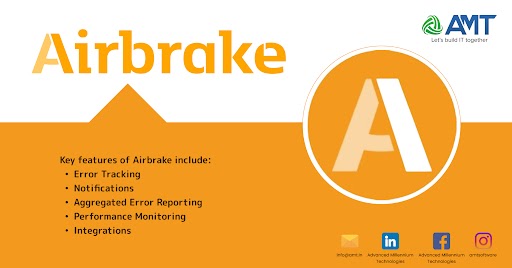Airbrake is an error monitoring and performance management tool used in software development. It helps developers track errors and exceptions that occur in their applications, providing insights into the root causes of issues and facilitating their resolution.
Key features of Airbrake include:
- Error Tracking: Airbrake captures errors and exceptions that occur in applications, including details such as stack traces, request parameters, and environment information.
- Notifications: Developers can receive notifications via email, Slack, or other channels when errors occur, allowing them to respond promptly to issues.
- Aggregated Error Reporting: Airbrake aggregates similar errors, helping developers identify patterns and prioritize fixes.
- Performance Monitoring: In addition to error tracking, Airbrake offers performance monitoring features, allowing developers to monitor application performance metrics such as response times and throughput.
- Integrations: Airbrake integrates with various development tools and platforms, including popular frameworks, issue trackers, and version control systems, streamlining the error resolution workflow.
Overall, Airbrake helps development teams improve the reliability and performance of their applications by providing insights into errors and performance issues.
Here are some additional details about Airbrake:
- Error Grouping: Airbrake intelligently groups similar errors together, reducing noise and preventing duplication of effort when investigating and resolving issues. This grouping feature helps developers identify recurring problems more efficiently.
- Custom Error Logging: Developers can log custom errors and exceptions in their applications using Airbrake’s API. This allows for more granular monitoring and tracking of specific types of errors that may be unique to an application’s codebase.
- Error Trend Analysis: Airbrake provides tools for analyzing error trends over time. This helps teams identify whether error rates are increasing or decreasing, enabling proactive measures to be taken to address underlying issues before they escalate.
- Deploy Tracking: Airbrake integrates with version control systems to track deployments and correlate them with changes in error rates. This feature helps developers pinpoint when errors were introduced or resolved, making it easier to identify the source of issues.
- Security: Airbrake prioritizes the security of error data, employing encryption and other measures to protect sensitive information. This ensures that error logs are kept confidential and comply with data protection regulations.
- Team Collaboration: Airbrake supports collaboration among team members by providing features such as commenting on errors, assigning tasks, and sharing insights. This facilitates communication and coordination when investigating and resolving issues.
- Flexible Deployment Options: Airbrake offers both cloud-hosted and self-hosted deployment options, allowing teams to choose the option that best fits their requirements and preferences.
Overall, Airbrake is a comprehensive error monitoring and performance management solution designed to help development teams streamline the debugging process, improve application reliability, and enhance overall user experience.
Above is a brief about Airbrake. Watch this space for more updates on the latest trends in Technology.
